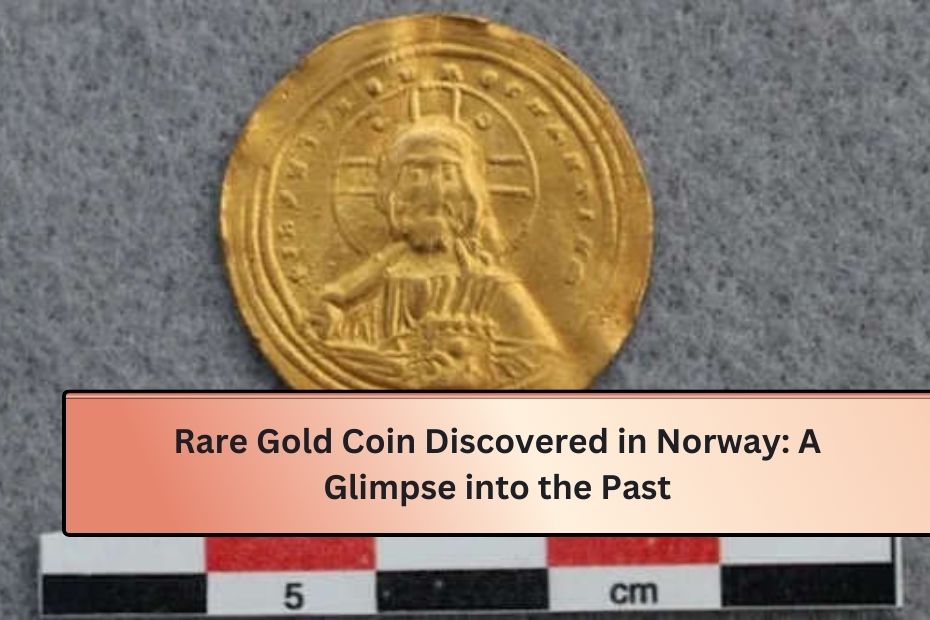Recently, a metal detectorist made a remarkable discovery in the mountains of central Norway. This find, an Rare Gold Coin, is believed to be a piece of lost history that may have once belonged to an early monarch. Let’s explore the fascinating details behind this discovery.
Discovery in Vestre Slidre
The Rare Gold Coin was unearthed in Vestre Slidre, a picturesque rural area in Norway’s south-central Innlandet County, famous for its skiing. The coin is technically known as a “histamenon nomisma,” which was first introduced around 960 C.E. and served as standard currency in the Byzantine Empire.
According to the Innlandet County Municipality, this ancient coin traveled over 1,600 miles from its origin to where it was found. The officials noted, “It has held up exceptionally well. The coin appears largely unchanged from when it was lost, perhaps a thousand years ago.”
A Look at the Coin
The coin showcases beautiful designs on both sides. One side features an embossed illustration of Christ holding a Bible. The reverse side likely depicts the Byzantine emperors Basil II and Constantine VIII, who ruled together at the end of the 9th century. Officials believe the coin was minted between 977 and 1025 C.E.
Inscriptions on the Coin
The coin also includes two inscriptions:
- On one side, in Latin, it reads: “Jesus Christ, King of those who reign.”
- On the opposite side, in Greek, it says: “Basil and Constantine, emperors of the Romans.”
These inscriptions not only highlight the religious significance of the coin but also its royal connections, making it an important artifact of the Byzantine Empire.
The Byzantine Empire
At its peak, the Byzantine Empire controlled a vast area surrounding the Mediterranean Sea, which included parts of Italy, Greece, Turkey, and regions of Northern Africa and the Middle East. The empire was renowned for its rich culture, stunning architecture, and significant contributions to art and philosophy.
Speculations About the Coin’s Journey
Officials from Innlandet have speculated about how this Rare Gold Coin might have traveled to Norway. One theory suggests that it could have belonged to Harald Hardråde, a Norwegian king who reigned from 1046 to 1066 C.E. Before becoming king, Harald served as a guard for the Byzantine Empire in Constantinople, the capital of the Byzantine Empire, known today as Istanbul.
During Harald’s time, it was customary for palace guards to loot valuables when an emperor died. As three emperors passed away during his service, it’s plausible that Harald acquired the coin in Constantinople and brought it back to Norway.
Another theory posits that the coin might have entered Norway through early salt trade routes, which connected different parts of the country. Salt was a valuable commodity, and these routes often facilitated the exchange of goods, including currency.
Future Investigations
Due to the late discovery in the fall season, the site where the coin was found will not undergo further investigation until next year. The authorities are keen to learn more about this important piece of history.
Other Notable Finds in Norway
This discovery isn’t the first of its kind. Just this past summer, another metal detectorist found nine pendants, three rings, and ten gold pearls on the southern island of Rennesoey, near Stavanger. In October, the Museum of Cultural History in Oslo announced the discovery of ancient gold-foil figures depicting images of Norse gods at a pagan temple site near Vingrom, about 100 miles south of the capital.
Conclusion
The discovery of this Rare Gold Coin in Norway opens a fascinating window into the past, connecting modern-day Norwegians with their rich history. As more artifacts like this are found, they help piece together the stories of ancient cultures and their influence on the world we know today.
This discovery not only excites historians and archaeologists but also enriches our understanding of how interconnected ancient societies were, even across great distances. The continued exploration of Norway’s historical sites may yield even more treasures from the past, providing insight into the lives of those who came before us.
Table
Here’s a table summarizing key details about the Rare Gold Coin discovered in Norway:
| Feature | Details |
|---|---|
| Name | Histamenon Nomisma |
| Type | Ancient Gold Coin |
| Origin | Byzantine Empire (likely minted in Constantinople, now Istanbul) |
| Estimated Date | Minted between 977 and 1025 C.E. |
| Discovery Location | Vestre Slidre, Innlandet County, Norway |
| Discovery Date | Fall season (exact date not specified) |
| Material | Gold |
| Dimensions | Not specified (details on size were not provided) |
| Design Side A | Christ holding a Bible |
| Design Side B | Emperors Basil II and Constantine VIII |
| Inscriptions | – Latin: “Jesus Christ, King of those who reign.” – Greek: “Basil and Constantine, emperors of the Romans.” |
| Theoretical Owners | Possibly belonged to King Harald Hardråde or circulated through early salt trade routes |
| Historical Significance | Provides insight into trade and cultural exchanges between the Byzantine Empire and Norway, showcasing the interconnectedness of ancient societies |
TWH News Home
FAQs
What is the significance of the Rare Gold Coin?
The coin provides insight into the trade and cultural exchanges between the Byzantine Empire and Norway.
How was the coin found?
It was discovered by a metal detectorist in the mountains of Vestre Slidre, Norway.
What do the inscriptions on the coin mean?
They refer to Jesus Christ and the co-emperors Basil II and Constantine VIII of the Byzantine Empire.
What theories exist about how the coin ended up in Norway?
One theory suggests it belonged to King Harald Hardråde, while another posits it may have traveled through salt trade routes.
What other discoveries have been made in Norway?
Recent finds include gold pendants, rings, pearls, and ancient gold-foil figures of Norse gods.

